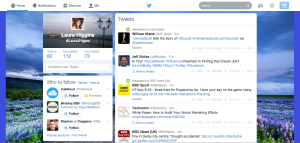Developing an online professional profile – Reflective Summary of Topic Three
Topic three sparked an interesting response amongst my peers and has encouraged me to share more of my personal job hunting experiences. The most common acknowledgement that came across was that recruiters are now using all social media platforms as recruitment screening tools. Throughout the comments on my blog we found many info-graphics that demonstrated this. This pie chart demonstrates that approximately 89% of US companies will use social media for recruiting purposes, (Jobvite Social Recruiting Survey 2011).
Therefore, it’s essential you are presenting yourself appropriately on these platforms. How you present yourself and the platform you use are all contributors to your online profile. This info-graphic demonstrates how you should use the right media to express your true self, for example if you’re creative, make videos. Or if you like to write, then blog!
A few people have asked me about my online profiles so I thought I would deliver a break down of the platforms I use.
1. Linkedin – a great way to create an online CV and connect with professionals. I used Linkedin a lot during my job search to find out about opportunities, follow companies and connect with recruiters. Since I started university my Linkedin has grown majorly and I wish to continue growing it because I think it will still be a valuable tool in many years to come. I also like how Linkedin has paired with many recruiting website so it can be used as an online CV and uploaded to job boards.
2. Twitter – I have two twitter accounts; one for this module (#UOSM2008) and to tweet relevant marketing material and another for personal use, to tweet the daily ramblings of my day-to-day activities. I have chosen to have two because my friends weren’t interested in my marketing tweets and vice-versa with the other account. I think it’s important that you post content that is interesting to your specific followers.
I also used twitter to find potential internships, follow employers and companies and stay on top of company updates and news. Many companies would follow me back and it was easy to connect to them via direct tweets or private messages.
3. Now that I know the facts I know recruiters will not miss out on the opportunity to search for me on Facebook, tumblr, Instagram, WordPress, Google+, Youtube and other social media sites. I make sure the information I publish on these platforms is non-aggressive, engaging, reflective of myself, relevant and ultimately appropriate.
I want them to want to hire me!
I think it’s important you still remain yourself on these networks. Don’t be a ‘professional robot’ because employers will see flaws in this persona. Be yourself, tweet your opinions, comment on friends photos, share links and make videos – promote your own online brand! Don’t be afraid to be a signal in a global audience. But remember that anything you post can be connected to you so think about the consequences before you submit!
Authenticity is still key and employers want to see you being, what some would say, normal. They know you’re not likely to be staying in every night of the week, especially if you’re a student, so go out, have fun and don’t be afraid to highlight this on social media. This article from the Telegraph suggests employers would rather see this authentic side to you as well http://www.telegraph.co.uk/education/universityeducation/student-life/9724871/Why-tipsy-Facebook-photos-beat-no-online-presence-at-all.html
Thoroughly enjoyed the response from this topic and the great interactions with my peers! Thanks guys, you all shared some valuable links, thoughts and reviews.
References







